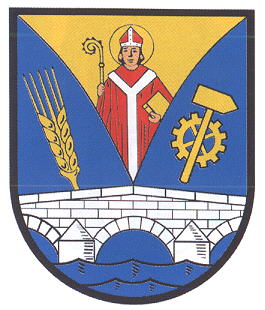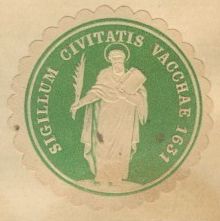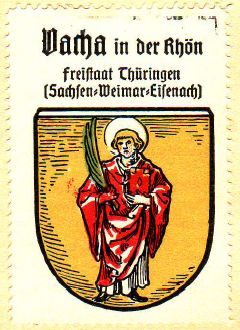Vacha: Difference between revisions
Jump to navigation
Jump to search
Knorrepoes (talk | contribs) No edit summary |
Knorrepoes (talk | contribs) No edit summary |
||
| Line 9: | Line 9: | ||
State : [[Thüringen]]<br/> | State : [[Thüringen]]<br/> | ||
District (Kreis) : [[Wartburgkreis]] (until 1994 [[Bad Salzungen (kreis)|Bad Salzungen ]]<br/> | District (Kreis) : [[Wartburgkreis]] (until 1994 [[Bad Salzungen (kreis)|Bad Salzungen]])<br/> | ||
Verwaltungsgemeinschaft : Vacha<br> | Verwaltungsgemeinschaft : Vacha<br> | ||
Additions : 1994 Oberzella | Additions : 1994 Oberzella | ||
| Line 24: | Line 24: | ||
|align="center"|[[File:vacha.hagd.jpg|center]] <br/>The arms in the [[Kaffee Hag albums]] +/- 1925 | |align="center"|[[File:vacha.hagd.jpg|center]] <br/>The arms in the [[Kaffee Hag albums]] +/- 1925 | ||
|} | |} | ||
[[Literature]] : Hupp, O: [[Kaffee Hag albums]], 1920s; Benzing et al, 1984; Ulle, 1998 | [[Literature]] : Hupp, O: [[Kaffee Hag albums]], 1920s; Benzing et al, 1984; Ulle, 1998 | ||
Revision as of 06:44, 18 December 2012
| Heraldry of the World Civic heraldry of Germany - Deutsche Wappen (Gemeindewappen/Kreiswappen) |
VACHA
State : Thüringen
District (Kreis) : Wartburgkreis (until 1994 Bad Salzungen)
Verwaltungsgemeinschaft : Vacha
Additions : 1994 Oberzella
Origin/meaning
The arms were granted on December 15, 1950 and confirmed on August 7, 1996.
The saint in the arms shows a bishop for either St. Bonifatius, the patron saint of the Fulda Abbey to which the town belonged in medieval times, or St. Vitus, the patron saint of the town. St. Bonifatius already appeared on the seal of the city in 1292, but was in the 17th century replaced by St. Vitus. The bridge is the bridge over the Werra, built in 1342. The other symbols represent agriculture and industry.
| Seal from around 1900 |
The arms in the Kaffee Hag albums +/- 1925 |
Literature : Hupp, O: Kaffee Hag albums, 1920s; Benzing et al, 1984; Ulle, 1998



